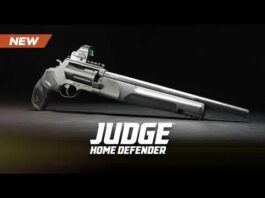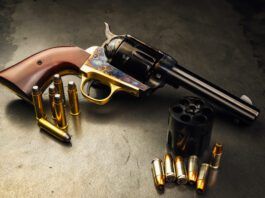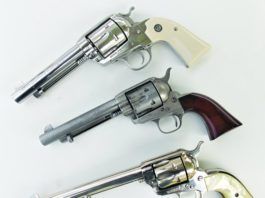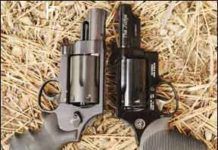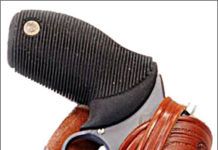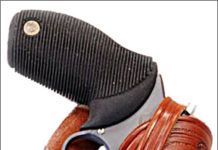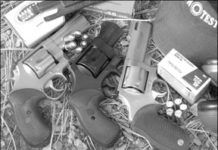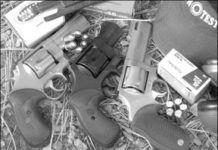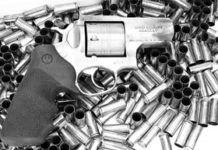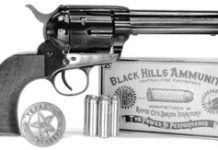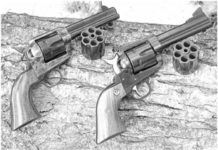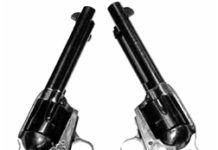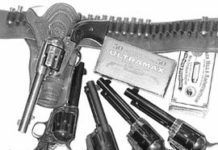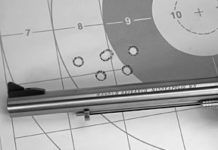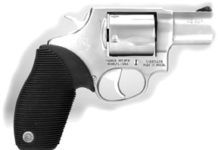Judging the Governor: We Pit Taurus and S&W Wheelguns
The new Smith & Wesson Governor is a six-shot revolver with scandium-alloy frame and matte-black finish that is being made to compete against the popular Taurus Judge. Like the Judge, the Governor handles 2.5-inch, 410 shotshells plus 45 Colt cartridges. The Governor also chambers 45 ACP ammunition, which the Judge does not. We still had the Taurus on hand at our Idaho office, so we took a close look at the two of of them side by side. Here's what we found.
Patterning the Taurus Judge
Patterning the Taurus Judge
Big-Bore Wheelguns: S&Ws Model 625 Is A Classy Choice
Big-Bore Wheelguns: S&Ws Model 625 Is A Classy Choice
Big-Bore Revolvers: For Power, Choose Rugers Super Redhawk
In this article we evaluate three guns that make no excuses for their girth. The Smith & Wesson Model 21-4 is a straightforward, large-frame revolver chambered for .44 Special only. Its .45 Colt brother, the Smith & Wesson Model 25-13, is slightly more modern, adding adjustable sights. The Ruger Super Redhawk Alaskan was fit with a longer cylinder, and together with its heavy frame, it is capable of firing .454 Casull as well as .45 Colt ammunition.
Our focus in this test was personal defense from humans and not bears, so we left the Casull rounds at home, but we did test an extra-heavy .45 Colt load from Atlanta Arms and Ammo formulated specifically for Ruger and Thompson Center firearms (
For our .44 Special rounds we chose 165-grain JHP rounds from Cor-Bon, Winchester's 200-grain Silvertip HP rounds, and 240-grain Truncated Cone Jacketed ammunition manufactured by Atlanta Arms and Ammo. Test distance was 25 yards from a sandbag rest. We fired single action only to collect hard data, but fired on steel targets double action only to evaluate rapid-fire capability. Limited to six-round capacity, we wanted to know which guns offered the right mix of power, accuracy, and speed. Here's what we learned:
Budget .45 Colt Cowboy Guns: Heritage Comes Up Shooting
According to a number of online dictionaries, there is no definition listed for the term, "cowboy gun." Nevertheless, the popularity of revolvers descending from the Colt Single Action Army has brought new meaning to these words. Since 1999 we have tested at least 18 different handguns that fit what we define as a cowboy gun, and now there are two more entering the market.
The Taurus Gaucho No. SA45B, $499, and the Heritage Manufacturing Big Bore Rough Rider No. RR45B5, $379, are six-shot single-action revolvers each with 5.5-inch barrels and chambered for 45 Colt. Some refer to this 1.6-inch-long straight-walled case with a 0.454-inch diameter bullet as .45 Long Colt, but in either case this caliber did not actually exist in the 19th Century. What is important is that these guns are for pleasure first, and they do not come with big price tags.
But their budget prices don't mean we're going to let them off the hook should they prove wanting in one area or another. Physically, the Gaucho and the Rough Rider could not be closer. Indeed, since they are replica guns, any variation from form, whether a positive innovation or not, would more than likely spoil their appeal. Both guns are dark-blued steel. Both guns have a tall front sight and a rear sighting notch exposed when the hammer is pulled back. Sight radius was equal. Each gun cylinder rotated clockwise, and with the loading gate open, the cylinders clicked with the indexing of each chamber. Ejector-rod movement was approximately 2.7 inches for each gun. The hammers on each gun lacked firing pins, using instead a transfer-bar system for greater safety. The Gaucho featured a plastic grip, but the grip on the Rough Rider was wood. The shape of the bell-shaped grips each started with a wide base that tapered to a 4.1-inch neck. Their weight, size, front strap and back strap height were nearly identical.
With so little to distinguish the two guns, our main concerns in this test were accuracy, fit, and function. Our test distance was 25 yards from a sandbag rest with four different choices of ammunition, two modern and two others sold in boxes decorated with Old West graphics. The modern rounds were Winchester's 225-grain Silvertip hollowpoints and Remington's 225-grain lead semi-wadcutters. The remaining ammunition brands, likely being marketed to Cowboy Action shooters, were 250-grain lead flat-point rounds from PMC and Black Hills Ammunition. We also looked back at other .45 Colt cowboy guns we have tested to see how these two newcomers stacked up within the category overall.
Convertible .45 Revolvers: Ruger and Cimarron Face Off
Ruger's Convertible may be worth the money, but we would pass on the fine Cimarron, whose ACP setup didn't work.
Three Cowboy Action Revolvers: Ruger, Beretta, and Cabelas
We thought Ruger's New Vaquero had teething problems, but we liked Beretta's Stampede. In our estimation, Cabela's Millennium still sets the value standard for .45 LC handguns.
.45 Single-Action Colts and Clones: USFAs Rodeo Is Our Pick
One hundred and thirty years ago Colt's brought out its Model P, also known as the Single Action Army revolver. (For those who wonder, Sam Colt never saw the Model P. He died in 1862.) The company is still making the old thumb-buster, and a host of companies are producing clones of it in what seems to be ever-increasing numbers. The game of Cowboy Action Shooting must surely be one of the main driving forces behind the continued onslaught of fine and finer single actions, but the fact remains that these revolvers are viable sporting, hunting, and even self-defense firearms, and serve their owners in as many capacities as they did in the 1870s.
Magnum Research BFR Revolvers
The market for big revolvers is actually rather small. The biggest-selling revolvers are smaller models that offer concealment or portability as well as simplicity. For hunting, a revolver or any other handgun should be of the largest caliber one can shoot for the sake of a quick kill. Then again, some very big revolvers are for the hunted. Super calibers like the .454 Casull and .480 Ruger can function as a more portable alternative to a rifle or shotgun in places like Alaska, where being surprised by a bear in your driveway isn't out of the question. Revolvers that shoot a rifle caliber are another way to go because rifle ammunition may indeed be cheaper and more plentiful than a specialty round like the .454 Casull or 480 Ruger. When Magnum Research expanded its line of BFR (biggest, finest revolvers) products to include models that chamber the .45-70 Government and .450 Marlin we decided to test them. First, we wanted to know if the guns themselves could stand up to these cartridges. We also wanted to see how much accuracy could be achieved when these rounds were placed in a revolver instead of a rifle. Here's what we found.
Big-Bore Snubbies: Taurus and Smith & Wesson Compete
We pit Taurus's small but weighty .45 ACP against S&W's bigger but lighter .44 Special and find two carryable revolvers with plenty of stopping power but surprisingly mild manners.


























